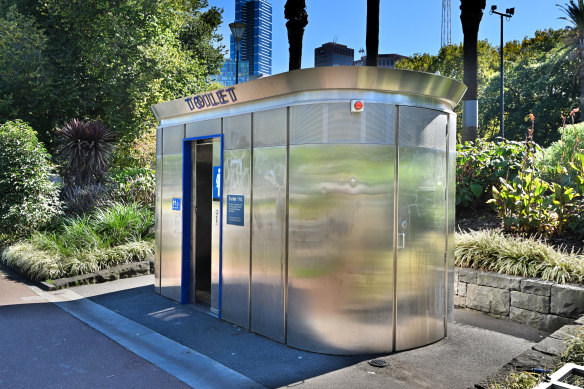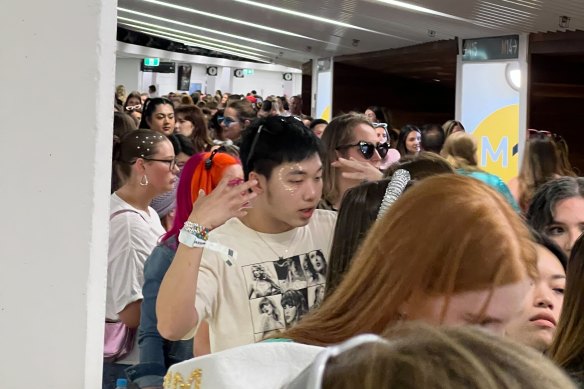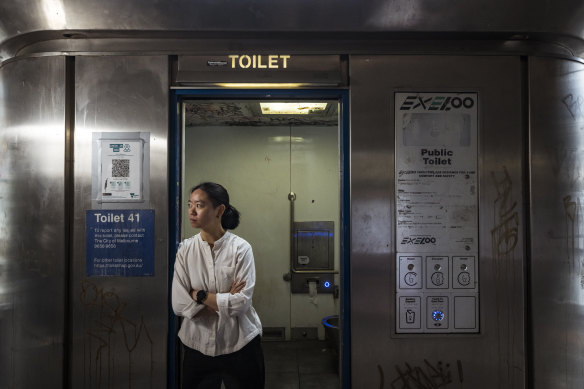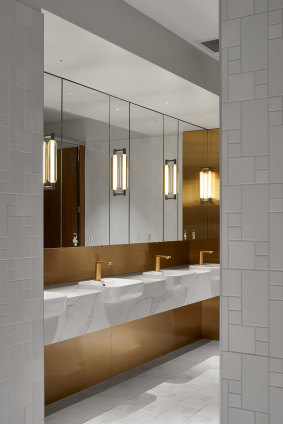This was published 9 months ago
Women are 34 times more likely to queue for the loo, while men are flush with options
Nina Ross loves going to shows, but there are rarely enough women’s toilets at Melbourne’s grand old theatres.
“Sometimes I’ve looked at the queue and thought, ‘Well, I can’t go to the toilet because I won’t make it to the end of the queue by the end of the interval’,” she says.
She ends up giving in and holding on, or using the men’s instead.
It’s not just the long queues for women’s toilets that are a pain – it’s the lack of family or unisex toilets for her young son. Ross has accompanied her nine-year-old son into the men’s toilets.
“No one seems to care. They knew I had a son and why I was doing this. Why can’t we just go to the toilet? Everyone goes to the toilet.”
Women and girls constitute more than half of the population, go to the toilet 1.3 times more often than males and for 1.6 times as long. Women also account for 80 per cent of people with incontinence.
Yet buildings usually have more facilities for men, leaving women 34 times more likely to queue.
“It is a historic design failure, of course,” says Professor Nicole Kalms, director of Monash University’s XYX Lab, which researches gender-sensitive design practices.
“Cities are historically built by men and don’t account for needs of women and other minoritised groups.”
Now there’s a push for women to have twice as many facilities as men.

A public toilet in Melbourne’s Queen Victoria Gardens. Credit: Joe Armao
The Australian Building Codes Board (ABCB) writes the National Construction Code, which stipulates the number of toilets in buildings. The board recognises that long queues for female public toilets have been an issue for many years – and blames it on women not using urinals.
“The net number of toilets provided for women is smaller than that for men. This can be attributed to the more efficient spacing of urinals in bathrooms. Overall, an average toilet area can accommodate from 20 to 30 per cent more fixtures [urinals and toilets] for men than for women,” it says.
The construction code is a minimum, not best practice. It does not require buildings to have more toilets for rush periods, or other facilities such as gender-neutral toilets or parent rooms.
“There’s nothing stopping someone putting in more toilets than the code requires,” says building surveyor Mark Filicietti. “But space is cost.”
Toilets are expensive to build or retrofit as they require many trades. They also take up space that could be devoted to money-making.
Public-toilet advocate Katherine Webber says the “rigid application of the [construction] code contributes to long waiting lines for women who, on average, take longer to use a toilet due to clothing, caring responsibilities, menstruation or pregnancy”.
The queues for women and girls are acute at theatres and cinemas, where people rush to toilets before and after shows, and during intermission. There, women and girls queue for 13 minutes during peak periods, compared with 9 minutes for men and boys, research shows.
The ABCB is proposing to increase the number of female toilets in single auditorium theatres and cinemas, to one male sanitary facility for every 1.8 female facility, compared with the current average ratio of 1 to 1.25.
But the proposed change will reduce, not kill, the gap. Under the change, women would still wait three to seven minutes longer than men. And the modest improvement in ratios wouldn’t apply to other public buildings.
Equal, except for the urinals
The Age contacted dozens of Melbourne’s major venues to see what percentage of their toilets were female toilets or accessible to women, such as unisex, accessible or family toilets.
The venues largely did not include urinals in their count, perhaps because they are difficult to count. But it makes toilet provision look more equal than it is in reality.

Fans face a long wait for the toilets at the MCG ahead of Taylor Swift’s first song on February 16.Credit: Eliza Sum
The MCG has 1712 sanitary facilities, including 419 metres of urinal troughs, which equates to between 600 and 700 urinals. It also has 66 “other” toilets: gender neutral, parent rooms and accessible. The stadium has a huge number of toilets, but not enough to prevent delays for the women’s at Taylor Swift’s concerts in February.
The Melbourne Museum says it has sufficient numbers of female toilets, despite only 42 per cent being women’s or unisex. “We have not received any reports of inadequate female or gender-neutral toilets on the premises,” it says.
The Arts Centre Melbourne reports 45 per cent public female toilets and a further 6 per cent gender-neutral or accessible. It says a renovation of Hamer Hall had increased the ratio to two-third female and one-third male.
Queen Victoria Market says it is adding more female toilets due to strong demand during peak times. Of its 53 toilets, 33 are for women and three are unisex, although its numbers did not include urinals.
Why are there not enough female toilets?
The building code states that sanitary facilities should reflect equal numbers of women and men in a building.
“But that does not mean you’re going to have the same number of sanitary facilities,” says Filicietti, a board member of the Building Surveyors and Inspectors Group.
Depending on the building type – a theatre or stadium, for example – and the maximum number of occupants at any one time, the code’s calculator will stipulate uneven numbers of male and female toilets.
“When you add up the number of closet pans and urinals for males, it will generally be more than the number of closet pans for females,” Filicietti says. “I would say the larger the number [of occupants], the more likely there’ll be more overall male facilities.”
Building owners can apply to permanently change their 50:50 ratio and change their male toilets to female or gender-neutral.
“They [building owners] could use historical data showing, ‘This is what we’re seeing on a constant basis and this is why we want to change the ratio of male or female toilets which is in the code’,” Filicietti says.
“Provided you had the data – and I don’t think a lot of these places have the data – you could.”

Samantha Lau says there should be two female public toilets for every male facility. Credit: Photograph by Chris Hopkins
The code hasn’t changed much in Filicietti’s 15-year career as a building surveyor.
“We don’t want to see a line of 50 females outside something and zero males. When I go to the theatre, I see it,” he says.
“I don’t think it will ever be a one-for-one – one toilet pan for male and one for women – but I think they are looking at doing some revision of the calculation and some inclusion for people who may not be of a male or female gender.”
The push for 2:1 female toilets
But for many, one female toilet for every male facility doesn’t go far enough.
Samantha Lau says the under-provision of female toilets is a “form of sex discrimination that reflects and perpetuates the poor treatment of women in society”.
Lau’s thesis on public toilets in the City of Melbourne and City of Port Phillip found 58 per cent of sampled toilets had more male facilities than female ones. A separate Age analysis of National Public Toilet Map data and population figures found Wyndham and Hume councils in Melbourne’s west had the lowest number of public toilets per 100,000 residents, while the well-to-do councils of Yarra and Mornington Peninsula had the highest.

The Round performing arts centre in Nunawading has more toilets than required.Credit: Shannon McGrath
“Because this is a systemic issue, we need structural solutions,” says Lau, who is now working as a consultant.
“One important step is to have a toilet ratio mandated in the National Construction Code that favours women. The widely accepted ratio is 2 to 1, based on existing research that says women take around double the time to pee. That would ensure true equity and prevent unequal waiting times at least for toilets in buildings.”
Beyond the bare minimum
Some places are going beyond the code’s bare minimum, including Melbourne Airport, which has spent about $70 million redoing its toilets.
Before COVID, toilets were the “number-one pain point” for both female and male travellers, says Wendi Pearce, head of traveller experience at Melbourne Airport.
“The airport is 50 years old so rather than say, ‘Let’s refurb’, we actually started again. We said, ‘Where do they need to be?’” says Pearce.
“As a business, we say we have to be 20 per cent above the building code.”
Another building with thoughtfully designed toilets is The Round, the City of Whitehorse’s new $78 million theatre in Nunawading. It has almost double the number of toilets required under the code.
“We wanted them to feel special and a little bit glamorous,” says architect Kerstin Thompson, whose firm worked with BKK Architects on the project. “It’s always the women’s that is the problem, which is why some of us go to the men’s.”
“We did things like remove urinals from men’s toilets so if in the future they wanted to change all the toilets to make them all gender-neutral, then they could,” says George Huon, principal of BKK Architects.
The Morning Edition newsletter is our guide to the day’s most important and interesting stories, analysis and insights. Sign up here.